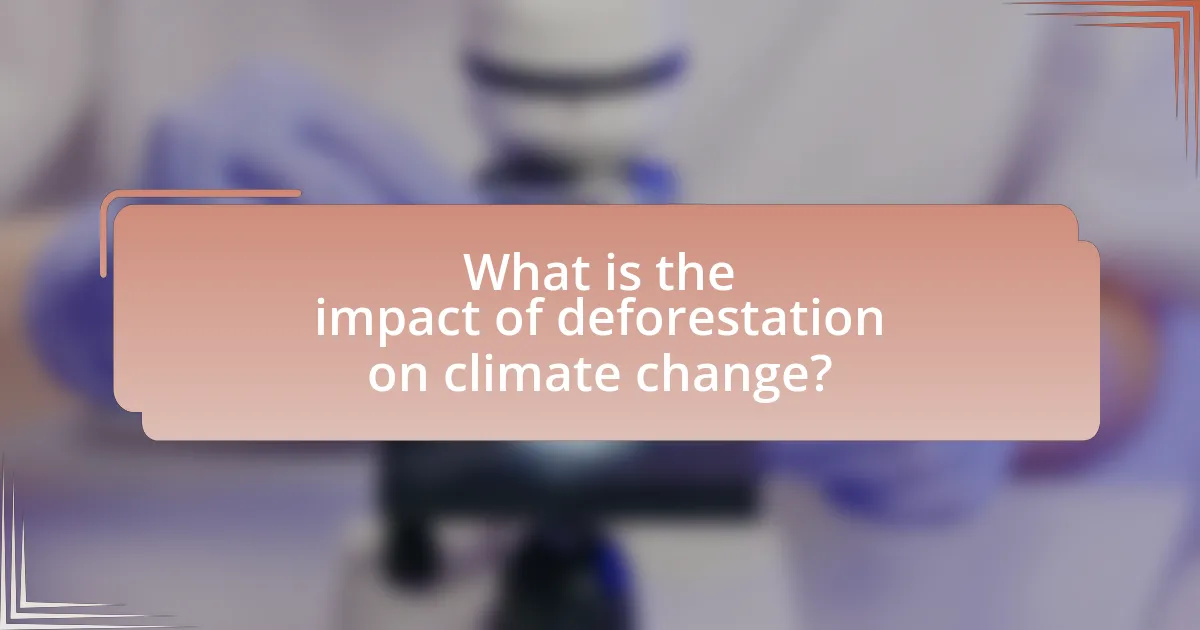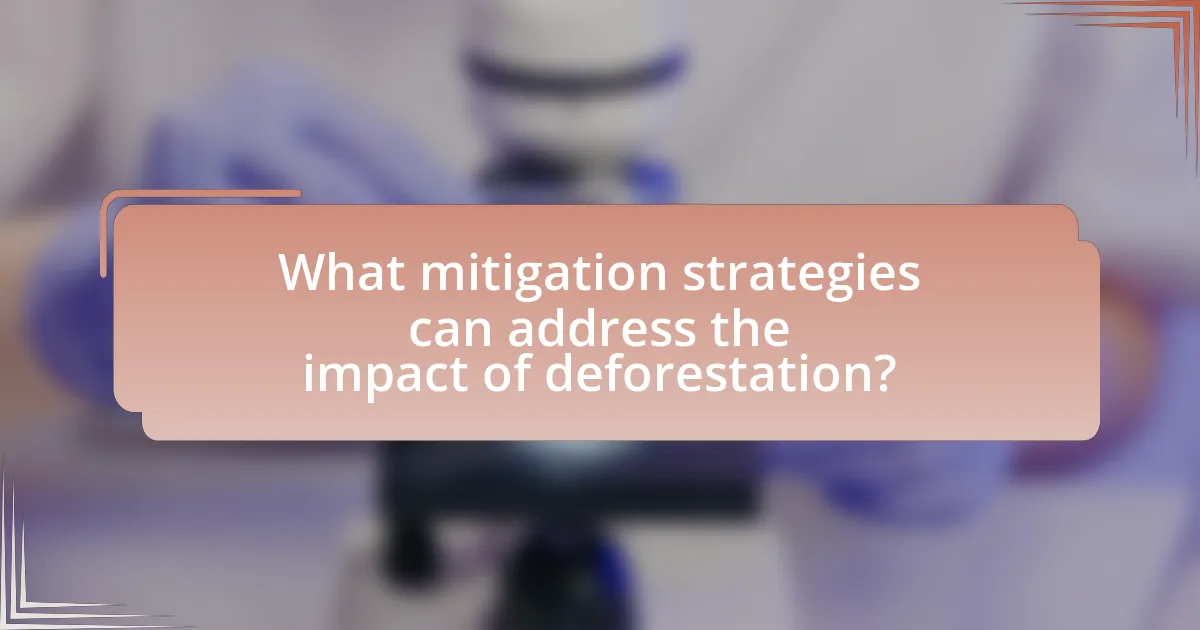Deforestation is a critical factor contributing to climate change, accounting for approximately 10-15% of global greenhouse gas emissions by releasing stored carbon dioxide and other greenhouse gases into the atmosphere. The article explores the mechanisms through which deforestation impacts climate dynamics, including its effects on global temperatures, biodiversity loss, and alterations in weather patterns. It also examines the socio-economic implications for communities reliant on forest resources and discusses various mitigation strategies, such as reforestation, sustainable forestry practices, and policy interventions, aimed at addressing the challenges posed by deforestation. Understanding these aspects is essential for developing effective climate action plans and promoting sustainable land management practices.

What is the impact of deforestation on climate change?
Deforestation significantly contributes to climate change by increasing atmospheric carbon dioxide levels. Trees absorb carbon dioxide during photosynthesis, and when they are cut down or burned, the stored carbon is released back into the atmosphere, exacerbating the greenhouse effect. According to the Food and Agriculture Organization, deforestation accounts for approximately 10-15% of global greenhouse gas emissions, highlighting its critical role in climate dynamics. This disruption not only accelerates global warming but also alters local weather patterns and reduces biodiversity, further impacting ecological balance.
How does deforestation contribute to greenhouse gas emissions?
Deforestation contributes to greenhouse gas emissions primarily by releasing stored carbon dioxide when trees are cut down or burned. Trees act as carbon sinks, absorbing carbon dioxide during photosynthesis; when they are removed, this stored carbon is released back into the atmosphere. According to the Food and Agriculture Organization, deforestation accounts for approximately 10-15% of global greenhouse gas emissions, significantly impacting climate change. The Intergovernmental Panel on Climate Change also highlights that land-use changes, including deforestation, are a major driver of increased atmospheric carbon levels, exacerbating global warming.
What specific gases are released during deforestation?
Deforestation primarily releases carbon dioxide, methane, and nitrous oxide. When trees are cut down or burned, the carbon stored in their biomass is released as carbon dioxide, significantly contributing to greenhouse gas emissions. Additionally, the decomposition of organic matter and soil disturbance during deforestation can lead to the release of methane and nitrous oxide, both potent greenhouse gases. According to the Intergovernmental Panel on Climate Change (IPCC), land-use changes, including deforestation, account for approximately 10-15% of global greenhouse gas emissions, underscoring the significant impact of these gases on climate change.
How do these emissions affect global temperatures?
Emissions from deforestation, particularly carbon dioxide and methane, significantly increase global temperatures by enhancing the greenhouse effect. When forests are cleared, stored carbon is released into the atmosphere, contributing to a rise in atmospheric CO2 levels, which have increased by over 40% since the pre-industrial era, according to the Global Carbon Project. This rise in greenhouse gases traps heat, leading to global warming. Additionally, deforestation reduces the planet’s capacity to absorb CO2, further exacerbating temperature increases. Studies indicate that deforestation contributes to approximately 10-15% of global greenhouse gas emissions, underscoring its critical role in climate change and temperature rise.
What are the ecological consequences of deforestation?
Deforestation leads to significant ecological consequences, including loss of biodiversity, disruption of water cycles, and increased greenhouse gas emissions. The removal of trees eliminates habitats for countless species, resulting in extinction and reduced biodiversity; for instance, it is estimated that deforestation contributes to the loss of approximately 137 plant, animal, and insect species every day. Additionally, trees play a crucial role in regulating the water cycle by absorbing and releasing water; their absence can lead to altered precipitation patterns and increased flooding. Furthermore, deforestation accounts for nearly 15% of global greenhouse gas emissions, primarily due to the release of carbon stored in trees, exacerbating climate change. These facts illustrate the profound ecological impacts of deforestation on ecosystems and the climate.
How does deforestation affect biodiversity?
Deforestation significantly reduces biodiversity by destroying habitats essential for various species. When forests are cleared, the intricate ecosystems that support numerous plants, animals, and microorganisms are disrupted, leading to habitat loss and fragmentation. According to the World Wildlife Fund, approximately 80% of terrestrial species reside in forests, making them crucial for maintaining global biodiversity. The loss of these habitats can result in species extinction; for instance, the International Union for Conservation of Nature reports that deforestation is a primary driver of the decline in over 1,000 species worldwide. Thus, deforestation directly correlates with decreased biodiversity, threatening the balance of ecosystems and the services they provide.
What role do forests play in carbon sequestration?
Forests play a crucial role in carbon sequestration by absorbing carbon dioxide from the atmosphere and storing it in biomass and soil. Through the process of photosynthesis, trees convert atmospheric carbon dioxide into organic matter, effectively reducing greenhouse gas concentrations. Research indicates that forests globally sequester approximately 2.6 billion metric tons of carbon annually, which is essential for mitigating climate change impacts. This significant carbon storage capacity highlights the importance of preserving forests to maintain their role in regulating atmospheric carbon levels.

Why is understanding deforestation important for climate mitigation?
Understanding deforestation is crucial for climate mitigation because it directly impacts carbon emissions and biodiversity loss. Deforestation contributes approximately 10-15% of global greenhouse gas emissions, primarily through the release of stored carbon dioxide when trees are cut down or burned. This significant contribution to climate change necessitates a comprehensive understanding of deforestation patterns and their drivers to develop effective mitigation strategies. For instance, the Food and Agriculture Organization (FAO) reports that sustainable forest management can reduce emissions and enhance carbon sequestration, highlighting the importance of addressing deforestation in climate action plans.
How does deforestation influence weather patterns?
Deforestation significantly alters weather patterns by reducing the amount of moisture released into the atmosphere through transpiration. Trees play a crucial role in the water cycle; when they are removed, the local humidity decreases, leading to drier conditions. This change can result in altered precipitation patterns, often causing regions to experience less rainfall and increased temperatures. For instance, a study published in the journal “Nature” found that deforestation in the Amazon rainforest has led to a reduction in rainfall by up to 20% in some areas, demonstrating a direct link between tree loss and changes in local climate.
What are the effects of altered weather patterns on agriculture?
Altered weather patterns significantly affect agriculture by disrupting crop yields and altering growing seasons. Changes in temperature and precipitation can lead to reduced agricultural productivity; for instance, a study by Lobell et al. (2011) published in “Science” found that climate change has already reduced global yields of staple crops like wheat and maize by approximately 5-10% per decade. Additionally, increased frequency of extreme weather events, such as droughts and floods, can damage crops and soil health, further threatening food security. These impacts highlight the vulnerability of agricultural systems to climate variability and the need for adaptive strategies to mitigate these effects.
How does deforestation impact water cycles?
Deforestation significantly disrupts water cycles by reducing the amount of moisture released into the atmosphere through transpiration. Trees play a crucial role in this process, as they absorb water from the soil and release it into the air, contributing to cloud formation and precipitation. When forests are cleared, this moisture release diminishes, leading to decreased rainfall and altered local and regional climates. Studies indicate that areas experiencing deforestation can see a reduction in rainfall by up to 30%, which can exacerbate drought conditions and affect water availability for ecosystems and human use.
What are the socio-economic implications of deforestation?
Deforestation has significant socio-economic implications, including loss of livelihoods, increased poverty, and disruption of local economies. The removal of forests often leads to the displacement of indigenous communities and smallholder farmers who rely on forest resources for their income and sustenance. According to the Food and Agriculture Organization, approximately 1.6 billion people depend on forests for their livelihoods, highlighting the critical role forests play in economic stability. Additionally, deforestation contributes to climate change, which can exacerbate economic disparities by affecting agricultural productivity and increasing the frequency of extreme weather events. This creates a cycle of vulnerability, particularly for marginalized populations who lack the resources to adapt.
How does deforestation affect indigenous communities?
Deforestation significantly disrupts indigenous communities by destroying their traditional lands and resources. These communities often rely on forests for their livelihoods, cultural practices, and spiritual beliefs. The loss of biodiversity and natural resources due to deforestation leads to food insecurity and loss of medicinal plants, which are vital for their health and well-being. According to the United Nations, approximately 370 million indigenous people worldwide depend on forests for their survival, highlighting the critical link between deforestation and the erosion of their cultural identity and economic stability.
What economic activities drive deforestation?
Agricultural expansion is the primary economic activity driving deforestation, particularly for crops like soy and palm oil. This expansion often leads to the clearing of vast forest areas to create arable land. According to the Food and Agriculture Organization, agriculture accounts for approximately 80% of deforestation globally. Additionally, logging for timber and paper products contributes significantly, with illegal logging practices exacerbating the issue. The World Resources Institute reports that logging activities account for about 14% of global deforestation. Furthermore, infrastructure development, such as road construction and urbanization, also plays a critical role by fragmenting forests and making previously inaccessible areas available for exploitation.

What mitigation strategies can address the impact of deforestation?
Mitigation strategies that can address the impact of deforestation include reforestation, afforestation, sustainable forestry practices, and agroforestry. Reforestation involves planting trees in deforested areas, which can restore ecosystems and sequester carbon dioxide; studies show that reforestation can sequester up to 1.1 billion tons of CO2 annually. Afforestation refers to planting trees in areas that were not previously forested, contributing to biodiversity and carbon capture. Sustainable forestry practices focus on managing forest resources to maintain their ecological functions while allowing for timber production, which can reduce the pressure on existing forests. Agroforestry integrates trees into agricultural landscapes, enhancing biodiversity and improving soil health while providing economic benefits to farmers. These strategies collectively contribute to mitigating climate change by enhancing carbon storage and preserving biodiversity.
How can reforestation contribute to climate change mitigation?
Reforestation contributes to climate change mitigation by sequestering carbon dioxide from the atmosphere. Trees absorb CO2 during photosynthesis, effectively reducing greenhouse gas concentrations. According to the Intergovernmental Panel on Climate Change (IPCC), reforestation can sequester approximately 1.1 to 2.6 gigatons of CO2 annually, depending on the scale and management practices employed. This process not only helps in lowering atmospheric CO2 levels but also enhances biodiversity, restores ecosystems, and improves soil health, further supporting climate resilience.
What are the best practices for successful reforestation projects?
Successful reforestation projects require careful planning, community involvement, and the selection of appropriate species. Effective planning involves assessing the local ecosystem, understanding soil conditions, and identifying native species that will thrive in the area. Community involvement is crucial, as engaging local populations fosters stewardship and ensures that the project meets the needs of those who live nearby. Research indicates that using native species enhances biodiversity and resilience, as these species are better adapted to local conditions and support local wildlife. A study published in the journal “Nature” highlights that projects incorporating local knowledge and practices have a higher success rate, demonstrating the importance of collaboration with indigenous communities.
How does reforestation compare to afforestation in terms of benefits?
Reforestation offers immediate ecological benefits by restoring degraded forests, enhancing biodiversity, and sequestering carbon dioxide, while afforestation creates new forests in previously non-forested areas, contributing to carbon capture over time. Reforestation can quickly improve soil quality and water cycles, as evidenced by studies showing that reforested areas can restore up to 80% of their original biodiversity within a few years. In contrast, afforestation may take decades to achieve similar ecological stability and biodiversity levels, as it involves establishing ecosystems from scratch. Therefore, while both strategies are vital for climate mitigation, reforestation tends to provide more rapid and measurable benefits in restoring ecosystems and combating climate change.
What role do policies play in reducing deforestation rates?
Policies play a crucial role in reducing deforestation rates by establishing regulations and incentives that promote sustainable land use practices. For instance, policies such as protected area designations and logging restrictions directly limit deforestation activities, while financial incentives for reforestation and sustainable agriculture encourage landowners to preserve forested areas. Evidence from Brazil shows that the implementation of the Forest Code and satellite monitoring significantly reduced deforestation rates by 80% between 2004 and 2012. These policies create a framework that balances economic development with environmental conservation, demonstrating their effectiveness in mitigating deforestation.
What are effective governmental policies for forest conservation?
Effective governmental policies for forest conservation include establishing protected areas, implementing sustainable forestry practices, and enforcing anti-deforestation laws. Protected areas, such as national parks and reserves, safeguard biodiversity and ecosystems, with studies showing that protected areas can reduce deforestation rates by up to 50%. Sustainable forestry practices, which involve managing forest resources to meet current needs without compromising future generations, have been shown to maintain forest cover while allowing for economic benefits. Enforcing anti-deforestation laws, such as Brazil’s Forest Code, has led to a significant decrease in illegal logging activities, contributing to a 70% reduction in deforestation in the Amazon from 2004 to 2012. These policies collectively support forest conservation and mitigate the impacts of climate change.
How can international agreements help combat deforestation?
International agreements can help combat deforestation by establishing binding commitments among countries to reduce forest loss and promote sustainable land management practices. For instance, the Paris Agreement encourages nations to set targets for reducing greenhouse gas emissions, which indirectly supports forest conservation efforts. Additionally, agreements like the United Nations Framework Convention on Climate Change (UNFCCC) facilitate financial and technical support for developing countries to implement deforestation-reducing initiatives. According to the Food and Agriculture Organization, global deforestation rates have decreased in regions where international cooperation and agreements are actively enforced, demonstrating the effectiveness of collaborative efforts in preserving forests.
What practical steps can individuals take to combat deforestation?
Individuals can combat deforestation by reducing their consumption of paper and wood products. By opting for digital alternatives, recycling paper, and purchasing products made from sustainable materials, individuals can significantly decrease the demand for timber. According to the World Wildlife Fund, responsible consumption can help protect forests, as the paper and pulp industry is a major driver of deforestation, accounting for approximately 40% of global deforestation. Additionally, individuals can support reforestation efforts by participating in tree-planting initiatives and donating to organizations focused on forest conservation. Engaging in advocacy for policies that protect forests and promote sustainable land use is also crucial, as informed citizens can influence legislation that addresses deforestation.
How can consumer choices influence deforestation rates?
Consumer choices significantly influence deforestation rates by driving demand for products linked to forest degradation, such as palm oil, beef, and timber. When consumers opt for products that are sustainably sourced or certified, they reduce the pressure on forests, as companies are incentivized to adopt environmentally friendly practices. For instance, the World Resources Institute reports that shifting diets away from beef could reduce deforestation by up to 70% in some regions, highlighting the direct correlation between consumer preferences and forest conservation efforts.
What are some community initiatives that promote forest conservation?
Community initiatives that promote forest conservation include reforestation projects, community-managed forests, and educational programs focused on sustainable practices. Reforestation projects, such as those led by organizations like Trees for the Future, aim to restore degraded lands by planting native trees, which enhances biodiversity and sequesters carbon. Community-managed forests empower local populations to sustainably manage their resources, as seen in the Community Forestry program in Nepal, which has successfully increased forest cover while improving local livelihoods. Educational programs, such as the Forest Stewardship Council’s outreach efforts, raise awareness about the importance of forests and encourage sustainable practices among community members. These initiatives collectively contribute to mitigating the effects of deforestation on climate change by preserving existing forests and restoring damaged ecosystems.


